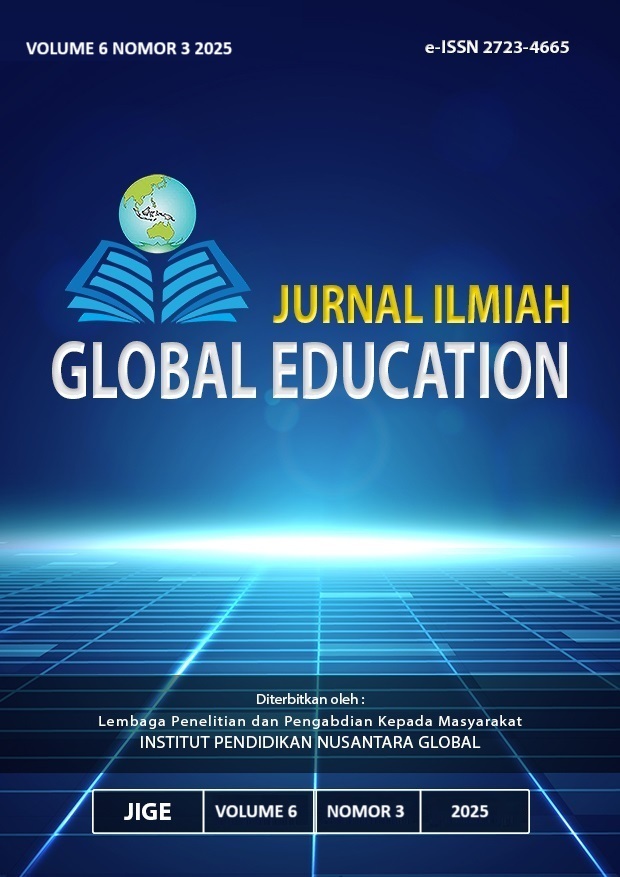Dampak Evaluasi Kinerja Terhadap Self-Efficacy Calon Konselor Sekolah dalam Melaksanakan Konseling Individu: Pendekatan Mixed Method
DOI:
https://doi.org/10.55681/jige.v6i3.4133Keywords:
Performance Evaluation, Self-Efficacy, School Counselor, Individual CounselingAbstract
This study examines the impact of performance evaluation (feedback) on the self-efficacy of counsellors in training in Indonesia using a mixed-method sequential explanatory approach. Quantitative analysis (SEM-PLS) revealed that feedback significantly influences self-efficacy (β = 0.323, p = 0.042), though with a modest effect size (R² = 10.4%). Qualitative findings identified three key themes: (1) constructive feedback (specific, solution-focused, and dialogic) as most effective, (2) self-reflection as a mediator, and (3) the critical role of a supportive environment. The study highlights the need for structured feedback rubrics, integrated reflection sessions, and collaborative evaluation practices to enhance self-efficacy. These findings contribute to the development of evidence-based training models for counselor preparation programs in Indonesia, addressing gaps in conventional evaluation systems.
Downloads
References
Bandura, A. (1997). Self-efficacy: The exercise of control. W.H. Freeman and Company.
Braun, V., & Clarke, V. (2006). Using thematic analysis in psychology. Qualitative Research in Psychology, 3(2), 77-101. https://doi.org/10.1191/1478088706qp063oa
BPS. (2023). Statistik pelayanan konseling sekolah di Indonesia. Badan Pusat Statistik.
Creswell, J. W., & Clark, V. L. P. (2018). Designing and conducting mixed methods research (3rd ed.). SAGE Publications.
Fitri Wahyuni. (2019). Skala pengukuran self-efficacy untuk konselor sekolah. Penerbit Universitas Pendidikan Indonesia.
Gysbers, N. C., & Henderson, P. (2016). Developing and managing your school guidance and counseling program (5th ed.). American Counseling Association.
Hair, J. F., Hult, G. T. M., Ringle, C. M., & Sarstedt, M. (2022). A primer on partial least squares structural equation modeling (PLS-SEM) (3rd ed.). Thousand Oaks, CA: Sage Publications.
Henseler, J., Ringle, C. M., & Sinkovics, R. R. (2009). The use of partial least squares path modeling in international marketing. Advances in International Marketing, 20, 277–319. https://doi.org/10.1108/S1474-7979(2009)0000020014
Ivankova, N. V., Creswell, J. W., & Stick, S. L. (2006). Using mixed-methods sequential explanatory design: From theory to practice. Field Methods, 18(1), 3-20. https://doi.org/10.1177/1525822X05282260
Kemdikbud. (2023). Laporan tahunan ketersediaan konselor sekolah di Indonesia. Kementerian Pendidikan dan Kebudayaan.
Larson, L. M., Anguiano, C., & Weston, R. (2020). The role of self-efficacy in counseling: A meta-analysis. Journal of Counseling Psychology, 67(3), 321-332. https://doi.org/10.1037/cou0000398
Linderbaum, B. A., & Levy, P. E. (2010). The development and validation of the Feedback Orientation Scale (FOS). Journal of Management, 36(6), 1372-1405. https://doi.org/10.1177/0149206310373145
Setiawan, A., & Kurniawan, B. (2021). Umpan balik konstruktif dalam pelatihan konselor: Studi kasus di Indonesia. Jurnal Psikologi Pendidikan, 15(2), 45-60.
Schunk, D. H., & Pajares, F. (2002). The development of academic self-efficacy. In A. Wigfield & J. S. Eccles (Eds.), Development of achievement motivation (pp. 15–31). San Diego: Academic Press.
Sink, C. A., & Stroh, H. R. (2020). School counseling: Foundations and contemporary issues. Cengage Learning.
Topping, K. J. (2010). Peers as a source of formative assessment. In H. L. Andrade & G. J. Cizek (Eds.), Handbook of formative assessment (pp. 61–74). New York: Routledge.
Downloads
Published
How to Cite
Issue
Section
License
Copyright (c) 2025 Adhi Krisna Maria Agustin, Mulawarman, Sutarmi

This work is licensed under a Creative Commons Attribution-ShareAlike 4.0 International License.












